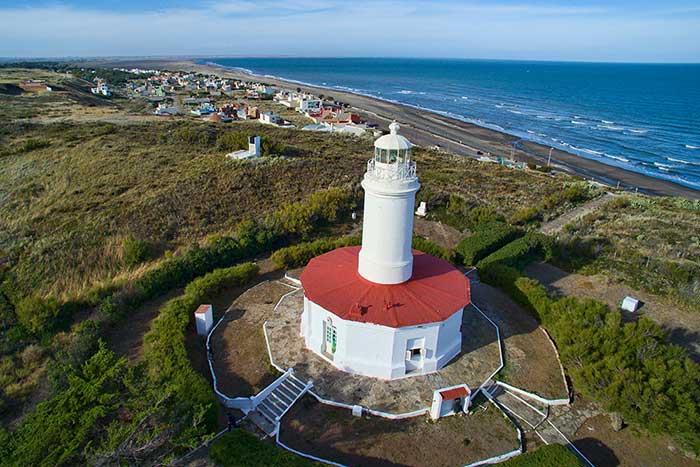Rio Negro Lighthouse
IALA Heritage Lighthouse of the Year 2023 Nominee
Location: ARGENTINA - Patagonian Region. Province of Rio Negro.
Lighthouse Operator: Ministerio de Defensa de Argentina and Servicio de Hidrografia Naval

Source: (photos as submitted to accompany nomination form by Argentine Naval Hydrographic Service - Ministry of Defence 2023)
Lighthouse Description and History
(Text extracted from nomination form submitted by Ministerio de Defensa de Argentina and Servicio de Hidrografia Naval 2023)
hill at the mouth of the Rio Negro to warn vessels of a dangerous bar.
PLACE– NAME ORIGIN
According to Father Falkner, the river was referred to as “kurú leuvú” by the natives, which means in araucano: Kurú = black and leuvú = river. Mr.
Gröeber in his book of place–names in araucano, titled “Toponimia araucana”, considers the words “kuri leo” or “leuvú” in araucano as the most appropriate origin, which are similar to the words suggested by Father Falker.
According to Santiago J. Albarracín, the name comes from the words Curu leuvú or río negro, which according to the tradition they derive from the fact that the region, when discovered by Bruñuel and Garcia, was under the rule of a chief that the natives called Negro. However, during a long period of time, the marines of the colonial era named it “Río de los Sauces” due to the large number of trees of this sort that were found along its margins.
GEOGRAPHIC SITUATION:
CHARACTERISTICS:
OPTICAL EQUIPMENT:
The light was originally illuminated by an oil lamp, which was later replaced by a kerosene gas device and then, by an acetylene gas lamp. Since 2020 to date, it has an electric 60 watt LED lamp and an optical device with a 16 NM range. Night characteristic: white light, 2 flashes every 20 second.
It was declared a Provincial Historic Monument in 2007, a National Historic Monument in 2013 and a World Heritage Site by the United Nations (UN) in 2017.
Reason For Nomination
(Text extracted from nomination form submitted by Ministerio de Defensa de Argentina and Servicio de Hidrografia Naval 2023)
Intrinsic Heritage Interest of the Lighthouse
Rio Negro Lighthouse is the oldest continental lighthouse in service in Argentina and the oldest in the Patagonia. It is a big-size building located over a 45 metre cliff at the mouth of Rio Negro, 32 km from the city of Viedma, the provincial capital.
It was inaugurated in 1887 thanks to the efforts of the governor of the province of Río Negro, General Lorenzo Vintter and Navy Lieutenant Colonel Martín Rivadavia, who understood the importance of having a lighthouse at the mouth of the Río Negro, given the existence of a very dangerous bar that hindered navigation.
On 8 October 1886, Navy Lieutenant Colonel Martín Rivadavia was authorized to build it. The construction was so quick that he asked for the authorization, which was granted by the Chief of the Navy Staff, Commodore Antonio Somellera, to inaugurate it on 15 May 1887. On 7 May 1887, the then President of the Republic, Dr. Miguel Juarez Celman, officially informed the Chief of the Río Negro Squadron, Lieutenant Colonel Martín Rivadavia, that the light was going to be put in service on that date.
Mr. Salvador Carlos Laria, in his book titled “El Faro del Río Negro” highlights the fact that in the morning of the day of the inauguration, small vapor vessel “Limay” from Rio Negro Squadron, commanded by Lieutenant Commander Hipolito Oliva, departed with a large delegation of almost one hundred people on board. After two hours and a half, they reached the mouth of the Río Negro, where small size vessels and boats waited for the Limay. They disembarked on the right margin of the river, from where a large caravan of carts, cars and horses set off for the lighthouse.
After Priest Piccono’s blessing, Commander Rivadavia formally handed over the Río Negro lighthouse facilities to the Governor of the Territory Governor General Vintter then expressed his thanks to the Commander and Officers of the Río Negro Squadron. After that, a 21-gun salute was fired and a Foundation Record was drafted.
The lighthouse was declared a World Heritage Site by the United Nations (UN) in 2017, according to the provisions under the International Convention of The Hague, and after having fulfilled a prerequisite: being a centenary lighthouse under Law No. 26,650. As a consequence of this award, the UN blue emblem is painted on its facade. It is worth mentioning that the emblematic tower of the El Cóndor beach resort had already been declared a Provincial Historic Monument in 2007 and a National Historic Monument in 2013.
Conservation
The light is well conserved. On-going preventive or corrective tasks are carried out by the staff of the Beaconing Department of the SHN.
Public Access and Education
This lighthouse can be visited at set times when the beaconing personnel from the SHN explain its operation and history as an aid to navigation, as well as the reason why it was declared a World Heritage Site. In addition, guided tours are given to different educational institutions. However, it is currently closed due to some maintenance work being carried out in the public access areas.
